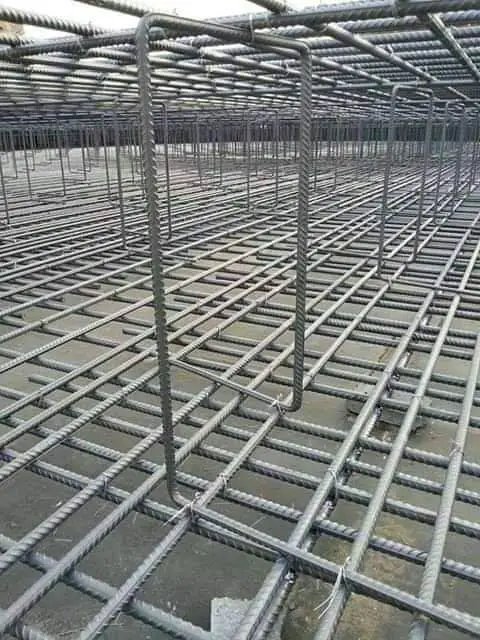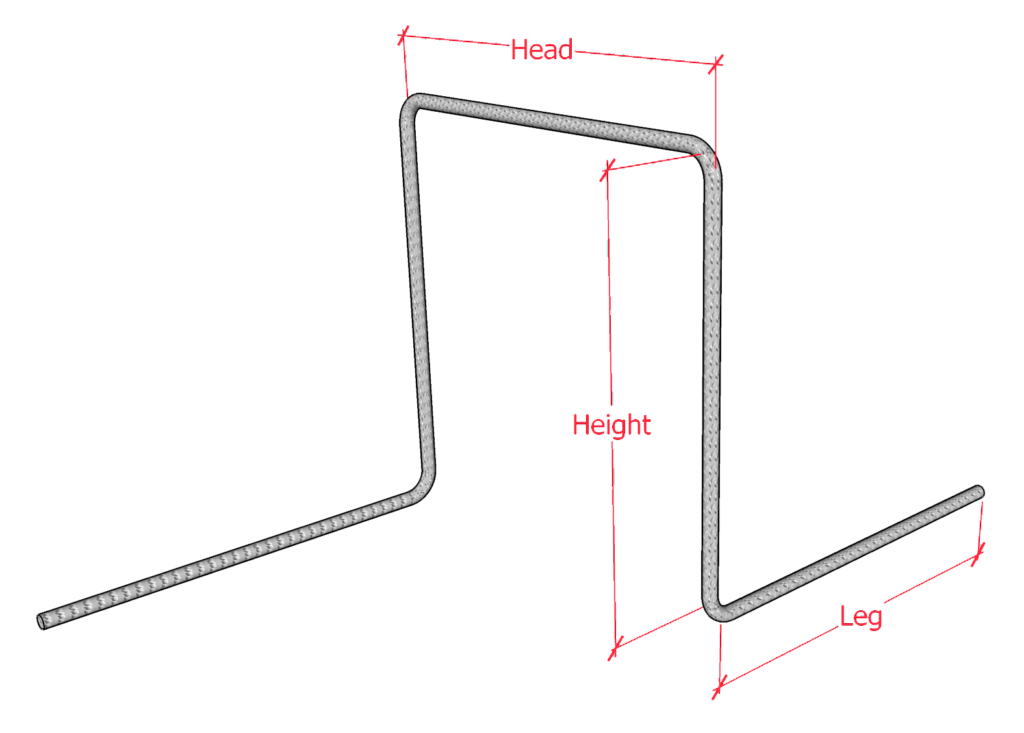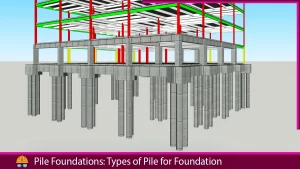The chair rebars, also known as chair reinforcement bars, are commonly used on construction sites, particularly for reinforced concrete works. It is designed to hold the rebar in place between two layers of tension and compression reinforcement mesh.
What is a Chair Bar?
Chair bars are a piece of bar bent to a shape (inverted U or Z) and placed in between the two layers of reinforcement mesh. They are provided to maintain the gap between the layers of the reinforcement bar. They also contribute to the stability of the reinforcement bar while concrete is pouring. They are usually provided between the compression and tension reinforcement mesh in footings and slabs.
As they are somewhat bent up like a chair, and provide a sitting arrangement for the upper mesh it is called chair bar in civil engineering words. Thus, the chair rebar can be defined as a rebar placed in between compression and tension reinforcement mesh to maintain the required gap and provide stability to the reinforcement arrangement.
Also, read: What is Cement Concrete?: Comprehensive Guide and 2 Types (PCC and RCC)

Shape of Chair Bars
The chair bar is bent to the shape of an inverted U or Z with the two legs and the head components. Rebar Chair bar has three components in general as listed below.
- Head of the chair bar
- Height of chair bar
- Leg of chair bar
Head of Chair Bar
It is the top horizontal part which supports the top mesh running across it. The length of the head for the chair bar is given by the formula: –
L1 = (2 x spacing of distribution bar) + (2 x the clear cover)
Height of Chair Bar
It is the vertical height of the chair bar. It connects the Head and Leg of the chair bar. Its length is given by the formula: –
L2 = Height of Footing/Slab -(2 x Clear cover) – (diameter of top and bottom distribution bar)
Leg of Chair Bar
It is the pair of parallel horizontal parts of the chair bar. Its function is to support the head and height of the chair bar. They are parallel in opposite directions. The length of the leg is given by the formula: –
L3= (2 x spacing of bottom bar) + 50
Note: –
1. Chair bar should be made of scrap rebar used in construction site in order to minimize the wastage of the materials..
2. Should not be less than 12 mm diameter.

How to Calculate Chair Bars Requirements?
For calculation, the requirements of the chair bar and the size (diameter) of the bar are calculated by first knowing the weight of the rebar that will be carried by the chair bars.
Diameter of Chair Bar
To find the diameter of the chair bar, the following are considered and computed
Weight of the distribution Bars
The load of the distribution rebar is calculated by the formula: –
\( W=\frac{10D^2}{162000} \)
where \(D\) is the Diameter of the distribution bars
Assuming the Diameter of Chair Bars
Once computing the weight of the distribution bar is done, the assumption of diameter for the chair bar is the next step. The diameter of the chair bars is determined by the dead load of the compression/top reinforcement bar in the footing or slab. The load has to be born by the design chair bar
The diameter of the chair bar is generally taken above 12mm diameter for all kinds of RCC works. The reason for not using the smaller dia. bars ( < 12mm ) is, that they tend to bend or buckle for the overladen loads. However, in some cases, 10mm dia bars are taken for the floor slab, when there is no extra external load other than reinforcement mesh load.
For the footing, it usually comes between 16mm to 25mm dia depending upon the size of the footing and the reinforcement bar used in compression mesh.
Check the Buckling Capacity of Rebar using Euler’s Formula:
After the assumption of the diameter, it is necessary to check the bulking capacity of the chair bar with the help of Euler’s formula. Maximum buckling force is given by the formula: –
\( P_{cr}=\frac{\pi^2EI}{KL^2} \)
Whereas:
- \(P_{cr}\): allowable buckling force
- \(E\): Modulus of Elasticity of Rebar
- \(K\): effective length factor = 1.0
- \(L\): unsupported length= 2.0m
- \(I\): Rebar’s area moment of inertia in m4 with the formula:
Also, read: Modulus of Elasticity of Concrete
\( I=\frac{\pi r^4}4 \)
and I is equal to 1.917 x10-8 m4
- \(K\): effective length factor = 1.0
- \(L\): unsupported length= 2.0m
Consider the ACI 318-14 code according to which the ϕ is the strength reduction factor as specified in table 21.2.1 given below.
| Actions or structural member | Strength reduction factor |
|---|---|
| Moment, axial force, or combined moment and axial force | 0.65 to 0.90 in accordance with 21.2.2 |
| Shear | 0.75 |
| Torsion | 0.75 |
| Bearing | 0.65 |
| Post-tensioned anchorage zones | 0.85 |
| Brackets and corbels | 0.75 |
| Struts, ties, nodal zones, and bearing areas designed in accordance with sturt – and – tie method in Chapter 23 | 0.75 |
| Components of connections of precast members controlled by yielding of steel elements in tension | 0.90 |
| Plain concrete elements | 0.60 |
| Anchors in concrete elements | 0.45 to 0.75 in accordance with Chapter 17 |
Spacing of Chair Bars
The next step after finding the diameter of the chair bar, the spacing of the bar is determining. Therefore, Since the chair reinforcements support only the top layer, we should consider the weight of the top mesh reinforcement as a dead load.
No of Bars/m2 = Factored Load / Pcr
Whereas,
Factored Load = 1.2Dead Load + 1.6 Live Load
Factor affecting spacing of chair bars
The spacing of the chair bars depends on several factors which are listed below: –
- Diameter of the bar used in making a chair. The larger the diameter of the bar, the more the spacing is, and vice versa.
- Type of the structural member.
- Diameter of the reinforcement bar of the RCC structure.
- External loads that act over the chair bar other than the rebar cage.
As such, there is no specification for the spacing of chair bars in the construction. In general, 1no. of chair bar is provided for the reinforcement cage area of 0.8sqm – 2sqm., depending upon the above factors.
Purpose of Providing Chair Bars
- To maintain the required gap between the upper & lower reinforcement cage in footings, slabs, raft foundations, etc.
- Maintaining the clear cover for reinforcement at the time of concrete vibration.
- Protecting the top & bottom cage from displacement and sagging at the time of concreting work, due to the movement of trolleys, walking of the workers, the dead load of the fresh concrete, etc.
- Providing extra support for the reinforcement bars.
Also, read: Development Length for Reinforcement Bar | Anchorage Length | Lap Length | Formula | Calculation
Example Calculation
For a 10m x 10m slab with chairs spaced at 1m and a required chair height of 0.3m:
1. Area of Slab: 10m×10m=100m2
2. Number of Chairs:
Lengthwise: \(\frac{10}1+1=11\)
Widthwise: \(\frac{10}1+1=11\)
Total Chairs = 11×11=121
3. Length of Each Chair Bar:
Length = 2×0.3m+0.5m+0.5m=1.6 m (assuming 0.5m horizontal lengths at top and bottom)
FAQs:
1: What is a chair bar?
Ans: The chair bar is a piece of extra reinforcement bar that is provided in between the tension and compression mesh layer in the footing and slab.
2: What should be the diameter of the chair bars?
Ans: The diameter of the chair bars should be calculated by the weight that the chair bar will be supporting from the upper (usual compression) reinforcement layer. Normally, the diameter of the chair bars is taken above 12mm.
3: What is a rebar spacer?

Ans: A rebar spacer is a piece of concrete block (usually 25 to 50mm cube or 50mm diameter cylindrical) intended to provide spacing between the outer surface of the finished concrete and the reinforcement inside. In simple, it is a concrete block provided to create the cover between the reinforcement bar and the concrete surface.
![]()





![Read more about the article Joints for Concrete Pipes [pdf]](https://civilengpro.com/wp-content/uploads/2022/11/JOINTS-FOR-CONCRETE-PIPES-300x169.jpg)

